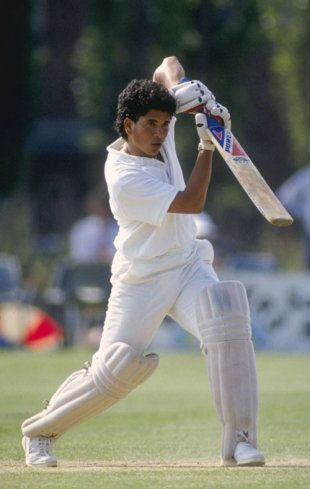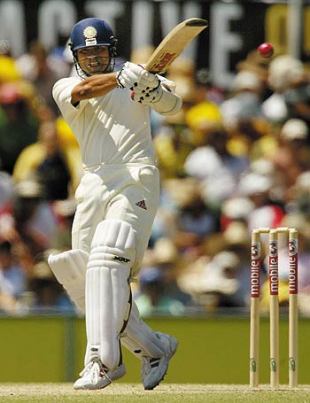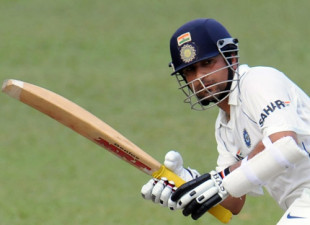A player of two parts
Why the man who now holds the record for the most runs in Tests is two batsmen in one
October 17, 2008
| | 
|
In November 1989, a London-based writer came to the Indian team's nets in Karachi to seek out a player he was told had the "best on-drive in the game". That player, Sachin Tendulkar, was 16 and yet to play a Test, but he already had his future mapped out - by others as much as by himself. Anything less than the most centuries and the highest aggregate in international cricket would count as failure.
Nearly two decades later, when the inevitable has come to pass, fans may be merely satisfied rather than overcome, and even quite blasé about it. If it was ordained, where is the surprise? Such is the tyranny of inevitability. It throws a veil over the hard work, the physical toll, the mental strain that have gone into the making of a record-breaker. Of the 19 batsmen who have scored more than 8000 runs, only five have held the highest aggregate record, only three have played 150 Tests, but only one, Tendulkar, has been two different batsmen.
Tendulkar made his debut in Pakistan. Of his team-mates then, one has become an insufferable television commentator, and two others have become good ones; one was convicted of murder and sent to jail, another banned for life for match-fixing. One eliminated the line between whistle-blower and perpetrator, one ran a banned series of matches, another was chairman of selectors. One has dropped out of the public eye and another has turned television actor. But Tendulkar bats on. Longevity is intrinsic to greatness.
At 19, the Mumbai boy was already the world's best batsman. Interestingly, Tendulkar seemed to agree with this assessment in a quiet, matter-of-fact way. This lack of arrogance possibly caused him to be less destructive in Test cricket than he might have been, but it was a crucial element in his becoming a national icon. Indians don't like their sporting heroes to be conceited; they give their hearts to modest players who underplay their emotions while performing consistently.
Of the two Tendulkars who played for India, the first had three or four shots for every ball; the second seemed conscious of three or four ways it could have got him out. Yet, amazingly, the spirit of the boy is ever present in the batsman, whether 16 or 35. A decade after making his debut, he was still teaching Shoaib Akhtar at the World Cup the difference between a good batsman and a great one. When pushed to the wall, Tendulkar continues to exhibit a rare creativity. It is not enough to somehow escape, it is necessary to escape while teaching the bowler a lesson he will never forget.
In sport as in art, late works usually crown a lifetime of effort. Looked at from either end of their careers, sportsmen present a harmonious picture. Occasionally, the "late style" (to borrow a phrase made popular by Edward Said) is about intransigence and unresolved contradictions. It doesn't fit into the whole.
Of the batsmen who have made over 9000 Test runs, six found their idiom at the start of their careers and kept with it (including, so far, the four still active). The later Brian Lara was not much different from the early Lara, the Allan Border who made his first run was the same as the one who made the 11,000th. The two exceptions are the Indians, Sunil Gavaskar and Tendulkar.
| Like great batsmen of any era, Tendulkar often seemed to be playing on a different planet altogether, keen to sculpt an innings that both merged with the team effort and stood out for its uniqueness | |||
It is not uncommon for batsmen who began their careers as leading stroke-makers to finish as part of the supporting cast. Age converts the carefree into the careworn. Rohan Kanhai is a good example of a batsman who began by inventing strokes against the best bowling and ended by playing "experienced" innings in the shadow of the next generation.
Experience often means that players are more aware of things in their own game that do not work, and are chary of taking chances. Why attempt a risky boundary when there is a safe single to be had? Firebrand speakers become merely adequate, daredevil adventurers become boring teachers, those renowned for thinking out of the box show how comfortable they are sitting in it. It is the same with sportsmen.
"Late style is what happens," wrote Edward Said in his study of musicians and writers, "if art does not abdicate its rights in favour of reality." Great players go against the grain as well as place themselves at the head of a trend.
Gavaskar who began his career as a generic name for batting technique, discovered late the joys of hooking fast bowlers; a ferocious attack on Malcolm Marshall and Michael Holding featured in his 29th Test century. It took him just 94 deliveries, and was one of the fastest in the game's history. This from a batsman who once took 60 overs to make 36 not out in a World Cup match.
Tendulkar's journey, though in the reverse direction, is no less dramatic. If Gavaskar found his responses within the tenets of orthodoxy, Tendulkar, no less orthodox for being a more attacking player, extended the reach of such orthodoxy. Five years ago he began to play a shot to the left of third man, which began with him withdrawing from the line of the ball delivered by a fast bowler and glancing it fine - but on the off side. It called for remarkable control and steely wrists. It wasn't as ugly as the reverse sweep, but lacked the grace of the "straight-bat pull", where he (and later, Virender Sehwag) whipped the ball, tennis-style cross court. Both strokes were created for the one-day game, but are no less effective when played wearing whites.
It may have been the Chennai defeat against Pakistan a decade ago that first sowed the seeds of the new Tendulkar. He was distraught at getting out so close to a win. He saw the need to be around; occupancy of the crease was not just a personal quirk but a team requirement. Tendulkar, the champagne cricketer with a dancer's footwork, curbed himself. He didn't actually become a clock-watching clerk, but he understood the need.
| | 
|
The series of injuries that followed - toes, back, elbow - meant that effervescence was replaced by effectiveness, the straight and narrow was preferred to the fantastic. Like great batsmen of any era, Tendulkar often seemed to be playing on a different planet altogether, keen to sculpt an innings that both merged with the team effort and stood out for its uniqueness. His Sydney double-century in 2004, when he scored no boundary between the bowler and point, came after self-examination revealed that he had been playing away from his body too often. It was almost as if the off side did not exist; on display was discipline as well as proof that he could get the bowlers to bowl where he wanted them to.
The boy who hit Abdul Qadir for three sixes in Peshawar had moved aside for the man who let the ball go outside the off stump with the realisation that not playing was an integral part of playing. In 110 matches before that Sydney Test, Tendulkar was involved in 31 wins; in the 39 Tests following it, he played his part in 16. The win percentage had gone up from 28 to 41 (obviously, there were other circumstances too). Tendulkar, an intelligent man, could not have been unaware of this. When individual effort does not contribute significantly to team victories, there is unhappiness all around. By 30, with nothing left to prove as a batsman, he set about correcting this nagging anomaly, this disconnect between his performance and the team's. If that meant he would have to cut out the flamboyance, then so be it. If fans complained that he was playing within himself, he could point to India's wins.
But Tendulkar is more than the sum of his figures. His mere presence is a morale booster, both for his ten colleagues in the team, and the billion supporters outside it. As remarkable as his record is his self-possession. His head hasn't changed size, his boots haven't grown smaller. He alone knows what it means to be Tendulkar, with its frustrations, its sacrifices, and the need to be Tendulkar at all times. He is a one-man university that teaches sportsmen how to handle money, fame and pressure.
Indians refuse to give Tendulkar the luxury of failure. The mirror he holds up to us is a distorted one, making us seem, like him, invincible, rich and accomplished. When he fails, therefore, it is as if we fail. That is the biggest compliment fans can pay their hero. But it is a heavy burden, even if Tendulkar seems to carry it lightly.
A rough calculation shows that he averages over 200 days in a year travelling for cricket, playing it at the highest level, or practising for it. Two-thirds of a year devoted to cricket, and not one bad day at work? Even Mozart was allowed an occasional off day. The future will treat Tendulkar much better than we have, although we were given the privilege of watching the boy grow into a man and live up to potential. Even that is a remarkable feat. Not every promising player accomplishes as much as he promises. Tendulkar has. Let us celebrate that. His record will be broken. But his impact will last.



